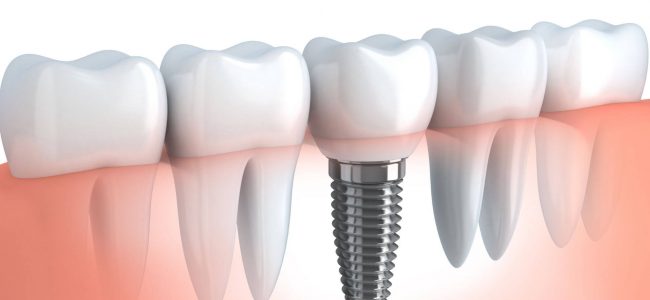How Long Does Pain Last After a Dental Implant?
Did you know that more than five million dental implants are placed each year by dentists in the United States? Or the history of dental implants spans thousands of years? For example, there is archeological evidence dating back to the Egyptians that people have attempted to replace missing teeth with materials like bamboo pegs, metal, and even ivory materials. Luckily, the materials now used to make dental implants are way more accepted by our bodies, and a proven and effective solution for missing teeth.
Before we get ahead of ourselves, first let’s discuss…what is a dental implant?
Dental Implant – The Basics
By definition, an implant is a surgical component that is placed into the jawbone and under the gums to support a dental prosthesis (like a crown, bridge, or denture). Resembling a wood-working screw, dental implants are most often made of titanium, a metal well-accepted by the body. Once the implant fixture or screw is surgically positioned by a dentist or oral surgeon, a replacement tooth can then be placed on top. Dental implants are a permanent solution to missing teeth because they act as a new tooth root and replace our natural teeth.
According to the American Dental Association, “Dental implants are an effective way to replace missing teeth. When teeth are lost because of disease or an accident, dental implants may be a good option.” Reasons to consider an implant include:
- Missing teeth from birth, childhood, injury, infection, or decay.
- Missing teeth from an injury.
- A solution to uncomfortable dentures and/or a removable partial denture.
- Unhappy with a removable partial denture.
What is the Process of Getting a Dental Implant?
The entire process of placing the implant and prosthesis takes several months. Obviously, the exact time frame depends on your dental health, as well as your dentist’s treatment plan. According to the ADA, implant treatment includes three basic steps:
- Placing the implant. After careful planning, your dentist will locate the location for the implant and perform the surgery. Once the implant is surgically placed, your dentist may prescribe pain medication for swelling and tenderness.
- Healing process. One of the most fascinating aspects of the dental implant procedure is a process called osseointegration, or the biological process of connecting bone to artificial material. Once your dentist places the implant, the next step is for your body to heal. During this healing process, the bone fuses with the implant screw. The ADA says, “It may take several months before the implant is completely integrated into the bone.”
- Placement of Dental Prosthesis. During this phase, you will visit your dentist to have a crown placed. A crown is an example of a dental prosthetic made out of porcelain to look like your natural tooth. Dentists take into consideration a number of factors when creating a crown-like shading, grooves, cusps, and material – just to name a few.
How Long Does Pain Last After a Dental Implant?
Now that we know more about the dental implant procedure, it’s easier to understand and gauge the pain involved. Having a dental implant placed is an outpatient procedure, meaning no overnight stay. Like any dental surgery, you may experience swelling of your gums and face, pain at the implant site, and/or minor bleeding after implant surgery. Your dentist may prescribe pain medication and antibiotics after surgery, as well as a diet of soft foods while the site heals. In most cases, the pain lasts three to five days after surgery. If pain lasts longer than two weeks or worsens, contact your dentist immediately.
A dental implant is the closest thing to a real tooth, plus a very effective way for replacing missing teeth. If you are interested in learning more about dental implants, and whether or not you are a good candidate, contact your dentist for a consultation.
